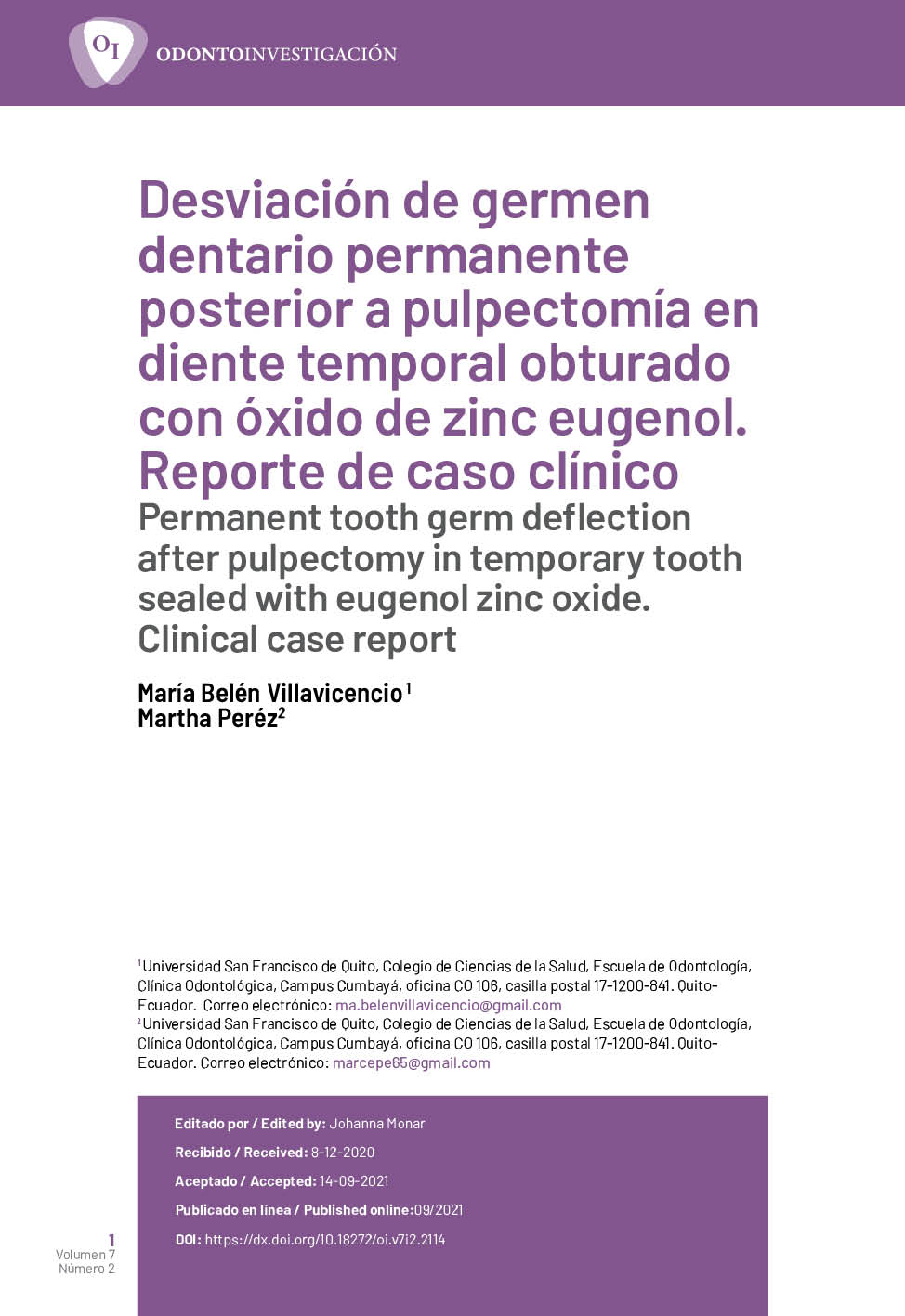Deviation of permanent tooth germ after pulpectomy filled with zinc oxide eugenol.
Main Article Content
Abstract
Zinc oxide and eugenol (ZOE) is the first recommended and most studied material, until 2008 it was the only material recommended by the American Academy of Pediatric Dentistry as a root canal obturator. However, ZOE has shown relatively lower rates of resorption or degradation in correlation of primary teeth rhizolysis, causing irritation in the periapical area, bone and cement necrosis, and deviation of the permanent tooth germ.
Therefore, the objective of this article is to verify that ZOE, after extravasation and its slower rate of degradation of primary teeth rhizolysis, can divert the permanent tooth germ. Faced with the diagnosis of persistence of the primary maxillary incisors due to extravasation and non-reabsorption of the obturator material (ZOE), the initial treatment in the reported clinical case was to perform the extraction of the dental units 5.2, 5.1, 6.1, 6.2 and the removal of extravasated obturator material remains to aid in the descent of the clinical crown of the permanent successor dental units. It should be noted that the obturator material (ZOE) caused, as evidenced by the literature, the deviation of the permanent germ (dental unit 2.1) which will subsequently be worked on in an interdisciplinary way.
Article Details
References
2. Villasana A. Patología pulpar y su diagnóstico. Salud Dental para Todos. 2002.
3. Lourenço Neto N, Fernandes AP, Marques NCT, Sakai VT, Moretti AB da S, Machado MA de AM, Abdo RCC, Oliveira TM. Terapia pulpar em dentes decíduos: possibilidades terapêuticas baseadas em evidências. Revista de Odontologia da UNESP. 2013. doi:10.1590/s1807-25772013000200011
4. Guideline on pulp therapy for primary and immature permanent teeth. Pediatric Dentistry. 2016.
5. Dean J, Avery D, Mc Donald R. Odontología para el niño y el adolescente. In: Odontología para el niño y el adolescente. 2014.
6. Perona G, Mungi S. Tratamiento Endodóntico no Instrumentado en dientes deciduos. Revista de odontopediatría latinoamericana. 2014.
7. Trejo-A, Cuevas-C. Materiales de obturación radicular utilizados en dientes deciduos. Revista de Odontopediatría Latinoamericana. 2014.
8. Barja-Fidalgo F, Moutinho-Ribeiro M, Oliveira MAA, Oliveira BH de. A Systematic Review of Root Canal Filling Materials for Deciduous Teeth: Is There an Alternative for Zinc Oxide-Eugenol? ISRN Dentistry. 2011. doi:10.5402/2011/367318
9. Jenny A. Evidencias científicas para la conducta clínica en bebés y preescolares. Primera ed. Sao Paulo: Quintessence; 2019.
10. Najjar RS, Alamoudi NM, El"Housseiny AA, Al Tuwirqi AA, Sabbagh HJ. A comparison of calcium hydroxide/iodoform paste and zinc oxide eugenol as root filling materials for pulpectomy in primary teeth: A systematic review and meta"analysis. Clinical and Experimental Dental Research. 2019;5(3):294-310. https://onlinelibrary.wiley.com/doi/10.1002/cre2.173. doi:10.1002/cre2.173

